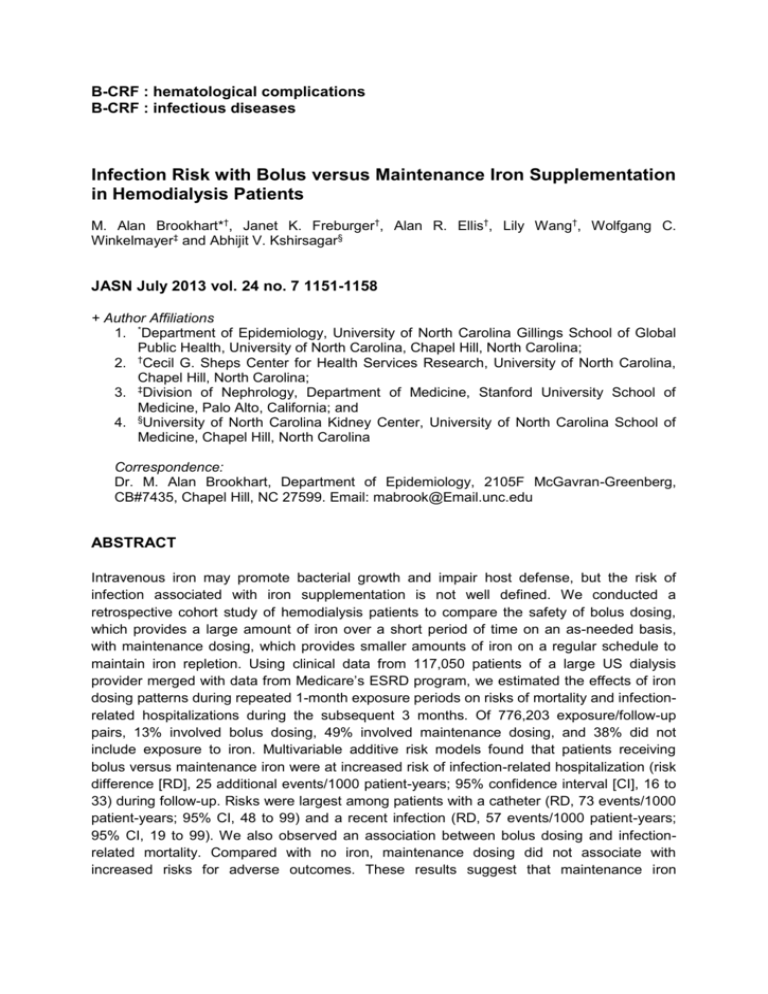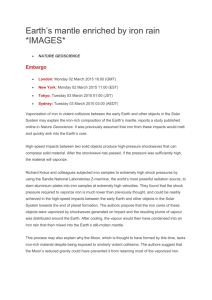Infection Risk with Bolus versus Maintenance Iron Supplementation
advertisement

B-CRF : hematological complications B-CRF : infectious diseases Infection Risk with Bolus versus Maintenance Iron Supplementation in Hemodialysis Patients M. Alan Brookhart*†, Janet K. Freburger†, Alan R. Ellis†, Lily Wang†, Wolfgang C. Winkelmayer‡ and Abhijit V. Kshirsagar§ JASN July 2013 vol. 24 no. 7 1151-1158 + Author Affiliations 1. *Department of Epidemiology, University of North Carolina Gillings School of Global Public Health, University of North Carolina, Chapel Hill, North Carolina; 2. †Cecil G. Sheps Center for Health Services Research, University of North Carolina, Chapel Hill, North Carolina; 3. ‡Division of Nephrology, Department of Medicine, Stanford University School of Medicine, Palo Alto, California; and 4. §University of North Carolina Kidney Center, University of North Carolina School of Medicine, Chapel Hill, North Carolina Correspondence: Dr. M. Alan Brookhart, Department of Epidemiology, 2105F McGavran-Greenberg, CB#7435, Chapel Hill, NC 27599. Email: mabrook@Email.unc.edu ABSTRACT Intravenous iron may promote bacterial growth and impair host defense, but the risk of infection associated with iron supplementation is not well defined. We conducted a retrospective cohort study of hemodialysis patients to compare the safety of bolus dosing, which provides a large amount of iron over a short period of time on an as-needed basis, with maintenance dosing, which provides smaller amounts of iron on a regular schedule to maintain iron repletion. Using clinical data from 117,050 patients of a large US dialysis provider merged with data from Medicare’s ESRD program, we estimated the effects of iron dosing patterns during repeated 1-month exposure periods on risks of mortality and infectionrelated hospitalizations during the subsequent 3 months. Of 776,203 exposure/follow-up pairs, 13% involved bolus dosing, 49% involved maintenance dosing, and 38% did not include exposure to iron. Multivariable additive risk models found that patients receiving bolus versus maintenance iron were at increased risk of infection-related hospitalization (risk difference [RD], 25 additional events/1000 patient-years; 95% confidence interval [CI], 16 to 33) during follow-up. Risks were largest among patients with a catheter (RD, 73 events/1000 patient-years; 95% CI, 48 to 99) and a recent infection (RD, 57 events/1000 patient-years; 95% CI, 19 to 99). We also observed an association between bolus dosing and infectionrelated mortality. Compared with no iron, maintenance dosing did not associate with increased risks for adverse outcomes. These results suggest that maintenance iron supplementation may result in fewer infections than bolus dosing, particularly among patients with a catheter. COMMENTS Anemia is common among patients with ESRD and associated with increased morbidity, mortality, and risk of hospitalization. The anemia of ESRD is managed primarily with erythropoiesis-stimulating agents (ESAs) and intravenous (IV) iron supplements. Despite the prevalence of anemia in ESRD and potential risks associated with ESAs, considerable uncertainty exists about the optimal use of ESAs and IV iron in this population. Iron treatment strategies have been reported to vary substantially among clinicians. Some physicians administer large repletion doses of iron, termed bolus dosing, over consecutive dialysis sessions on an intermittent, as-needed basis. Others physicians instead provide lowdose administrations of iron, termed maintenance dosing, every 1–2 weeks to maintain iron stores. Currently, there is little evidence regarding the safety and effectiveness of these different approaches to iron supplementation. Infection risk has been a persistent concern associated with IV iron use in hemodialysis patients. Frequent administration of iron may lead to oversaturation of transferrin and the release of free, catalytically active iron into circulation. Because iron is essential for bacterial growth, free iron may plausibly cause infection or worsen an existing infection. Iron is also believed to impair host immune response by decreasing function of polymorphonuclear leukocytes. In summary, bolus or repletion dosing of iron, a common contemporary dosing strategy, may increase the short-term risk of infections that require hospitalization. This risk seems to be particularly elevated in patients with a catheter and those patients with a history of a recent infection.







